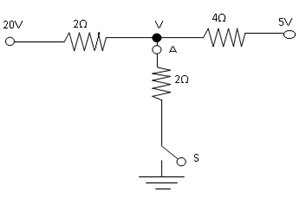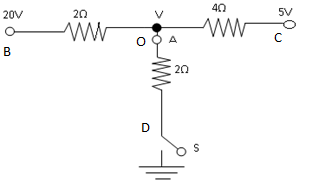
A switch S is closed in the circuit shown in figure, current passed through point A is?

A.
B.
C.
D. Zero

Answer
477.9k+ views
Hint: We are given to find the value of current through point A. The resistance values of all branches are given, to find the current we need to first find the value of voltage. Use Kirchhoff’s junction rule to find the value of voltage V and then calculate the value of current passing through point A.
Complete step by step answer:
To find the current at point A, we will use Kirchhoff’s junction rule.
According to Kirchhoff’s junction rule, the sum of all the currents entering and leaving a node in a circuit is always equal to zero.
Let us name the branches for simplicity

Now, we find the current through each branch
Current through branch BO is
Current through branch CO is
Current through branch CO is
Now, applying Kirchhoff’s junction rule at point O we get
Putting the values of
Now, the current through the DO branch is
Putting the value of
So, the correct answer is “Option A”.
Note:
There are two Kirchhoff’s laws which are used to find the value of current and voltage of circuits. The first law is Kirchhoff’s current law or junction law which states that the sum current entering and leaving a junction of an electrical circuit is always zero. The second law or also known as voltage law states that the sum of the voltage drops around any closed circuit is always zero.
Complete step by step answer:
To find the current at point A, we will use Kirchhoff’s junction rule.
According to Kirchhoff’s junction rule, the sum of all the currents entering and leaving a node in a circuit is always equal to zero.
Let us name the branches for simplicity

Now, we find the current through each branch
Current through branch BO is
Current through branch CO is
Current through branch CO is
Now, applying Kirchhoff’s junction rule at point O we get
Putting the values of
Now, the current through the DO branch is
Putting the value of
So, the correct answer is “Option A”.
Note:
There are two Kirchhoff’s laws which are used to find the value of current and voltage of circuits. The first law is Kirchhoff’s current law or junction law which states that the sum current entering and leaving a junction of an electrical circuit is always zero. The second law or also known as voltage law states that the sum of the voltage drops around any closed circuit is always zero.
Latest Vedantu courses for you
Grade 11 Science PCM | CBSE | SCHOOL | English
CBSE (2025-26)
School Full course for CBSE students
₹41,848 per year
Recently Updated Pages
Master Class 9 General Knowledge: Engaging Questions & Answers for Success

Master Class 9 English: Engaging Questions & Answers for Success

Master Class 9 Science: Engaging Questions & Answers for Success

Master Class 9 Social Science: Engaging Questions & Answers for Success

Master Class 9 Maths: Engaging Questions & Answers for Success

Class 9 Question and Answer - Your Ultimate Solutions Guide

Trending doubts
Give 10 examples of unisexual and bisexual flowers

Draw a labelled sketch of the human eye class 12 physics CBSE

Differentiate between homogeneous and heterogeneous class 12 chemistry CBSE

Differentiate between insitu conservation and exsitu class 12 biology CBSE

What are the major means of transport Explain each class 12 social science CBSE

Draw a diagram of a flower and name the parts class 12 biology ICSE




